The percussive chorus of Duran Duran’s Wild Boys does a good job of filling in the spacious base lodge cafeteria at Owl’s Head. Are they still called cafeterias? Back in 1984, when Wild Boys was vying for top-of-the-charts honours with Madonna and Hall and Oates, that’s the word I would have used for ski resort eateries. They often had turnstiles you’d enter before grabbing a tray for your burger and fries then sashaying up to the cashier.
But the news out of Quebec’s Eastern Townships is that Owl’s Head has moved well past the 1980s—even if it was only last year. Duran Duran now registers as nostalgia in this place with fresh drywall where once there was stucco and wood panelling. The picnic tables still have that ageless chipped-varnish look, but the menu options speak of a fresher, gluten-optional age. And that’s just the beginning.
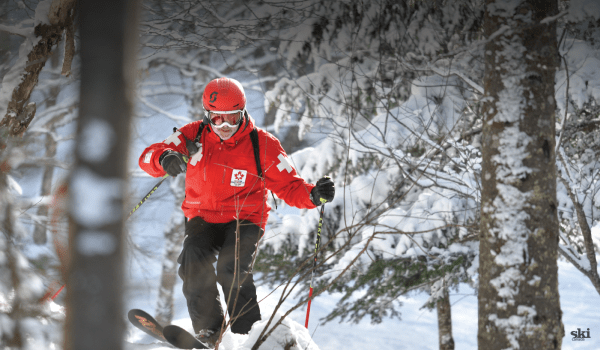
One of four major ski resorts in the Eastern Townships, Owl’s Head is the farthest off the beaten path for most travellers. Those who drive the extra half-hour past the turnoffs to Orford or Sutton often find themselves developing a loyalty toward this peak with its 540-metre vertical drop and six chairlifts. The regulars say they are drawn to its unparalleled scenery, a relaxed atmosphere and an easily understood and navigated run layout that is oriented vertically off one peak.
It’s the end of a spring day at Owl’s Head. With a stiff wind off the magnificent Lake Memphremagog, the snow remains supple and the lineups on this Sunday between Quebec and Ontario March breaks, non-existent. All of which means lots of turns for my now-tired legs as I creak down the stairs toward the lockers in the bottom level of the base lodge.
My RFID card opens the locker that’s assigned to me as a guest of the hotel upstairs. No combinations or keys needed. I hang my boots on the posts and they automatically start venting fresh air to dry my boots from within as I trade up to après-ski footwear.
The dive bar/arcade that used to take up much of the lower level of the lodge is gone, replaced by the new rental centre and boutique shop. To look for a pitcher of Blue or, I guess, one of those hop stews in a glass that are more of the present day, I need to go up one more flight of stairs to the high-vaulted, window-filled hall that until last year was relegated to dining room duty.
When I was last here three years ago, the room was replete with folded napkins fanning out of waiting water glasses on linen tablecloths. The previous chalet-style ambience has given way to whitewash walls. To be fair, there isn’t much wall showing between the nine wall-mounted television screens, all with sound muted but displays flashing to entice the eyes of anyone needing a hit of distraction instead of enjoying the mountain view outside.
The business case for upgrading this central space from a rarely used dining room to an all-day and evening restaurant and bar is obvious. It’s a great room that will get more use, and collect more money, now. But words like quaint, charming and cozy, which once defined this space, no longer come easily to mind.
I’m at the bar, swiveling around on my stool and wondering whether mulling over this makes me a cranky traditionalist, and I must be doing it out loud because I’m answered by two guys on nearby stools sharing a pitcher of old-school Molson Export.
If anyone has a right to feel nostalgic about the way things were at Owl’s Head, it’s Mark Richardson. But he’s having none of it. “Everything has a lifespan,” he explains. “It was time for renewal.”
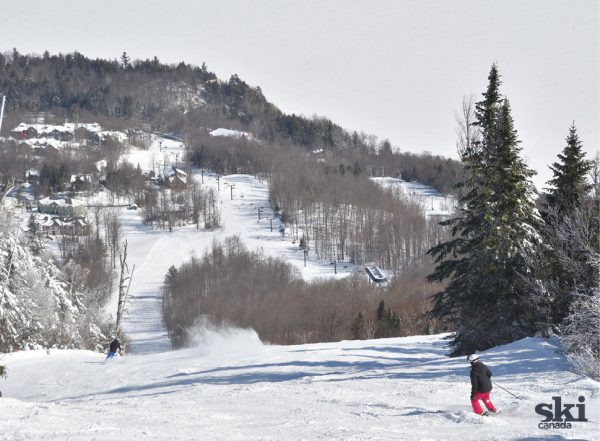
Richardson’s father was Bob Richardson, an Olympian and member of the national ski team. In the 1930s Bob was just a kid growing up in nearby Magog when the local doctor won a pair of skis in a contest and gave them to Bob. He and a friend (in fact, the uncle of the guy sharing the pitcher with Mark) took the skis into a barn, made a duplicate pair and then started learning how to get down the surrounding slopes on the northwest margins of the Appalachians.
Bob turned those first homemade skis into a 10-year career on the national ski team (1948-1958), during which time he was pressed into extra service by the government of B.C. They flew him to the top of a pre-developed Whistler and asked him to ski down to Creekside to evaluate the prospects of hosting an Olympics there.
Soon after, Bob settled back near home to work at the now-defunct Glen Mountain. His new son Mark often spent time in a baby basket behind the ski shop desk.
By 1965, Fred Korman, an electrical engineer from nearby Mansonville, had bought out his brothers of much of the family property on and around the peak they call Owl’s Head and was stringing lift cables up its flanks. To give his hill and ski school some credibility, he poached Bob, with three-year-old Mark in tow, from Glen Mountain. Bob was a fixture here until his death in 2004, doing all aspects of ski school and resort operations. It’s his face on the memorial plaque bolted to the granite face greeting skiers as they glide off the summit chairlift.
Since the beginning, Mark Richardson has skied, and often worked, at Owl’s Head. “I can’t tell you how many pairs of boots I’ve burned trying to dry them out in front of that fireplace,” he says, nodding toward one of two stone fireplaces in the bar.
All of that time, Owl’s Head was under the ownership of Korman—until last summer. The new owners have opted for anonymity, but it’s an open secret that the group is led by business owners from Montreal, regular skiers who have children in the ski club. To focus on their identities might not be as helpful as looking at what they’ve done since taking over at the end of the 2017-18 season.
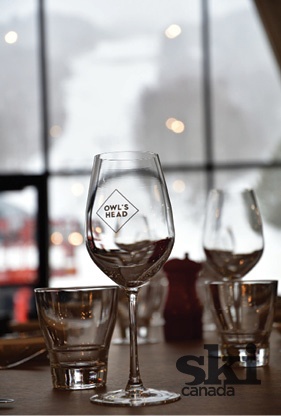
“They’ve done a first-class job,” says Richardson, clearly preferring the view from the new, airy bar over the one from the lower-level beer hall of yesteryear. But it’s up one more flight of stairs where the change is most noticeable. The only on-hill, hotel-style accommodation at Owl’s Head remains the Auberge, except it’s now called the Mtn Haus Hotel and its 20 smaller rooms have been consolidated into 10 suites that sit atop the large cafeteria hall. The rooms received much of the attention of the $5-million base lodge renovation that hurried to transform the building between April and November.
Three years earlier I had stayed in a room that had saggy mattresses and an extraordinarily small bathtub, or perhaps it was a deep-basin shower stall. Post-reno, the honey-brown wood beams have been painted out and the new shower stall has the same footprint as the whole bathroom did in my previous room.
Both rooms in our suite opened up onto small patios overlooking the resort’s compact base area. The monochromatic colour scheme is a little stark, but all told the comfort level has been given a huge boost. A mini fridge, microwave, coffee maker and two televisions rounded out the amenities. No worries with raising my voice to get the kids to turn the television off in their room at night—the walls have been soundproofed. As Richardson had noted, “You used to be able to hear people snore from three rooms away.”
Richardson has returned for a tour of duty at the ski school this year, in part to accompany his son, the third generation to teach at Owl’s Head. I arrange to meet him for some runs the next day between classes.
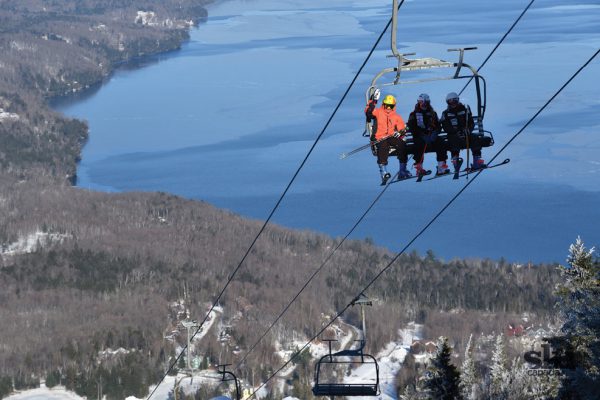
My impression of Owl’s Head was always that it had sustained, wide, cruiser runs that never strayed too far from the fall line of the conical peak. As for what nooks and crannies lie between the runs, I was hoping Richardson was going to help me out.
He starts by leading me through some hardwood trees between Kamikazee and Colorado. The gladed areas are not extensive, but the runs at Owl’s Head tend to be spaced far apart. There’s a lot of real estate under the trees, for someone with the time and determination to hunt for secret lines of his own.
We emerge again on Colorado, still high enough to skate out to the Lake View Chair. It’s quiet out here, at the far lower east corner of the run network. The chairlift’s bullwheels haven’t turned at all this season. General Manager Pierre Bourdages would later tell me that an inspection last fall indicated it would be too expensive to maintain it in a safe and reliable way for the first year of the new regime. This past off-season it has been replaced with a new quad. It’s a fixed grip but has a loading carpet to allow for the cable to run at higher speeds (2.5 m/s).
Richardson recounts walking the area with his father, surveying the slope to lay out the lift line. It’s not hard to see where the name comes from. The Lake View Chair rises hard off the banks of Lake Memphremagog, a finger lake running for 40 km north-south. There’s a slight bend in the middle and Owl’s Head’s slopes come right down to the outside arc of that bend, positioning it perfectly for the types of views you’ll find at few other ski areas.
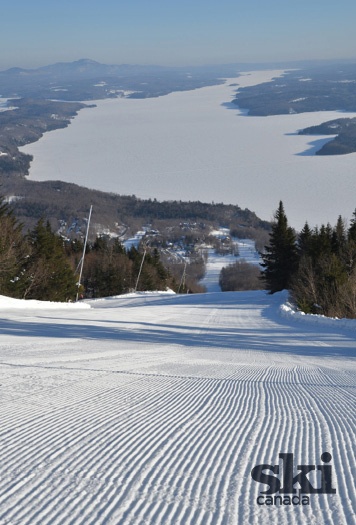
“Our own Lake Tahoe,” says Richardson. “It’s gorgeous here, especially in the spring.” I can’t imagine anyone disagreeing.
We curl around Lake View run and Richardson points out some tangents that have been recently gladed. I imagine the snow in there lasts for ages, being out-of-the-way glades on a mountain that doesn’t generally attract tree skiers. Whether it’s Lily’s Leap or Colorado, the main thrust of Owl’s Head is cruisers.
“We ski so much better here, because of the flat fall line,” says Richardson. It doesn’t hurt that that fall line ends at a picturesque lake.
And it’s not just the orientation of the slopes that has him excited. More recently it’s the condition of them.
Bourdages had explained to me that over the previous summer $8 million had been spent on snowmaking. The new system is more responsive, able to sense conditions like humidity and regulate itself to adjust the amount of water in the mix. The result, he explained, is not just better-quality snow but more snow able to be made at marginal temperatures.
Richardson says it paid off. “The snowmaking is 10 out of 10,” he judges. “It was a challenging season. It seemed to rain every week, but throughout it only ever took two days for it to recover.” It used to take the old system three weeks to cover the trail in front of his chalet, Chouette. The new system does it now in three days.
According to Bourdages, the system revamp was cut short when half a metre of snow fell in November. This off-season saw the overhaul all but completed.
“There was a lot of stuff that had been neglected,” sums up Richardson, but now everyone is talking about the incredible snow conditions. “The regulars are happy.”
He pushes off to pick up speed for the short hill we’ll need to ascend to get back to a running lift. He and his dad won’t be laying out the new lift line, but it’s a safe bet it won’t stray too far from the original.



